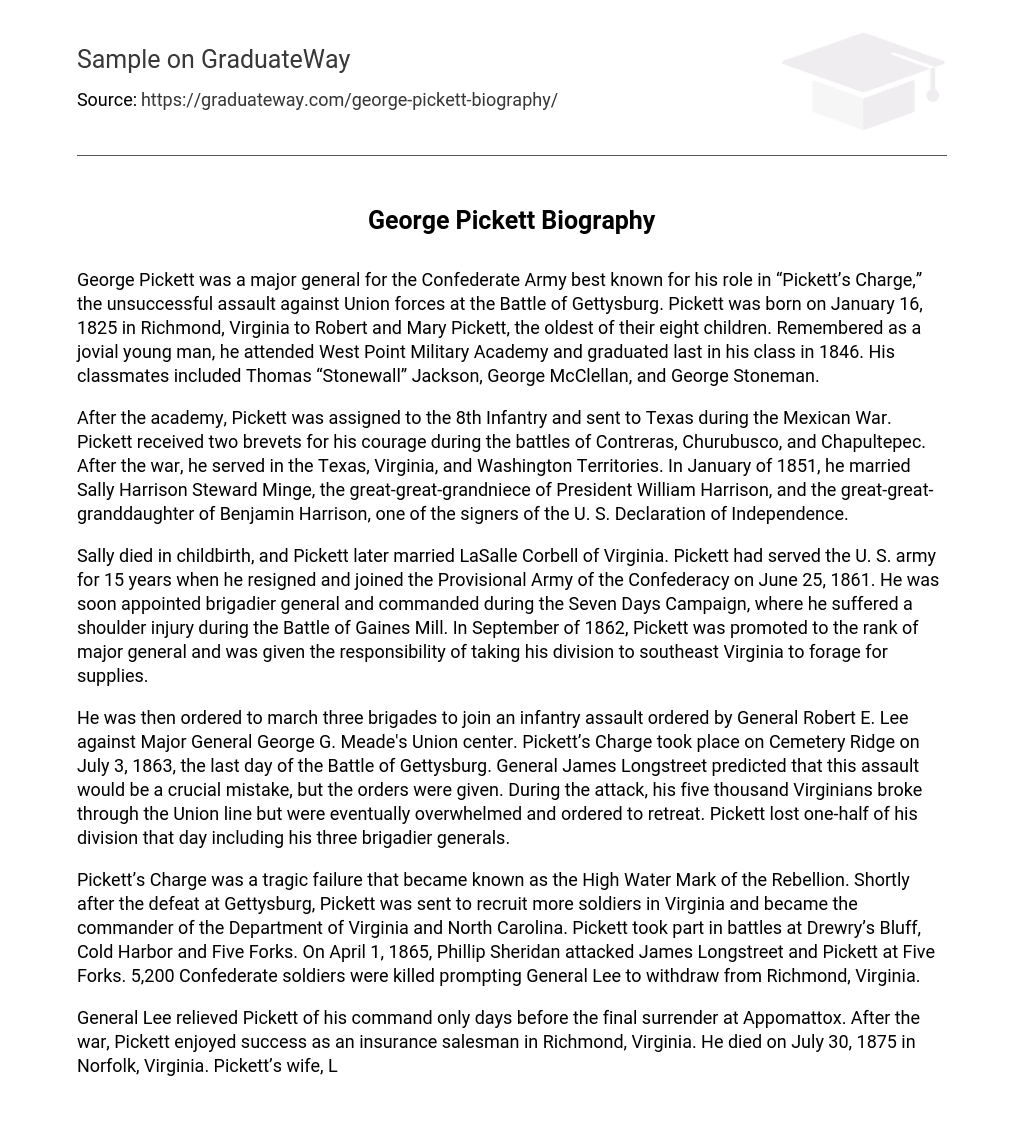George Pickett was a major general for the Confederate Army best known for his role in “Pickett’s Charge,” the unsuccessful assault against Union forces at the Battle of Gettysburg. Pickett was born on January 16, 1825 in Richmond, Virginia to Robert and Mary Pickett, the oldest of their eight children. Remembered as a jovial young man, he attended West Point Military Academy and graduated last in his class in 1846. His classmates included Thomas “Stonewall” Jackson, George McClellan, and George Stoneman.
After the academy, Pickett was assigned to the 8th Infantry and sent to Texas during the Mexican War. Pickett received two brevets for his courage during the battles of Contreras, Churubusco, and Chapultepec. After the war, he served in the Texas, Virginia, and Washington Territories. In January of 1851, he married Sally Harrison Steward Minge, the great-great-grandniece of President William Harrison, and the great-great-granddaughter of Benjamin Harrison, one of the signers of the U. S. Declaration of Independence.
Sally died in childbirth, and Pickett later married LaSalle Corbell of Virginia. Pickett had served the U. S. army for 15 years when he resigned and joined the Provisional Army of the Confederacy on June 25, 1861. He was soon appointed brigadier general and commanded during the Seven Days Campaign, where he suffered a shoulder injury during the Battle of Gaines Mill. In September of 1862, Pickett was promoted to the rank of major general and was given the responsibility of taking his division to southeast Virginia to forage for supplies.
He was then ordered to march three brigades to join an infantry assault ordered by General Robert E. Lee against Major General George G. Meade’s Union center. Pickett’s Charge took place on Cemetery Ridge on July 3, 1863, the last day of the Battle of Gettysburg. General James Longstreet predicted that this assault would be a crucial mistake, but the orders were given. During the attack, his five thousand Virginians broke through the Union line but were eventually overwhelmed and ordered to retreat. Pickett lost one-half of his division that day including his three brigadier generals.
Pickett’s Charge was a tragic failure that became known as the High Water Mark of the Rebellion. Shortly after the defeat at Gettysburg, Pickett was sent to recruit more soldiers in Virginia and became the commander of the Department of Virginia and North Carolina. Pickett took part in battles at Drewry’s Bluff, Cold Harbor and Five Forks. On April 1, 1865, Phillip Sheridan attacked James Longstreet and Pickett at Five Forks. 5,200 Confederate soldiers were killed prompting General Lee to withdraw from Richmond, Virginia.
General Lee relieved Pickett of his command only days before the final surrender at Appomattox. After the war, Pickett enjoyed success as an insurance salesman in Richmond, Virginia. He died on July 30, 1875 in Norfolk, Virginia. Pickett’s wife, LaSalle Corbell believed that her late husband was an extraordinary war hero and told his story in her book, Pickett and His Men. Speaking at Pickett’s funeral, George B. McClellan said, “Perhaps there is no doubt that [Pickett] was the best infantry soldier developed on either side during the Civil War. “





